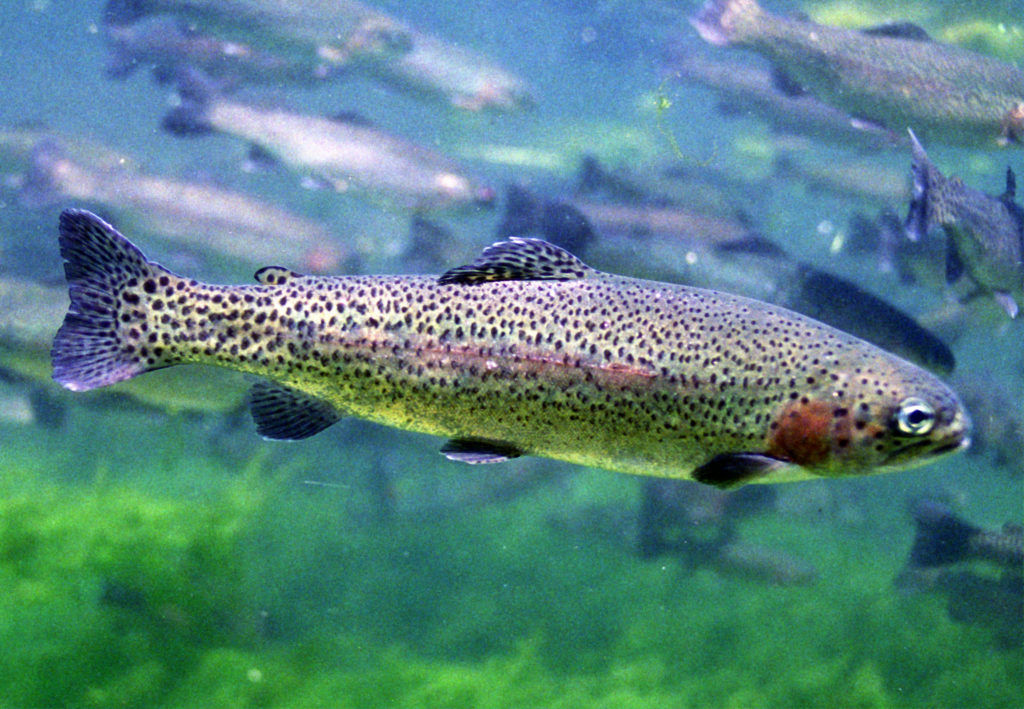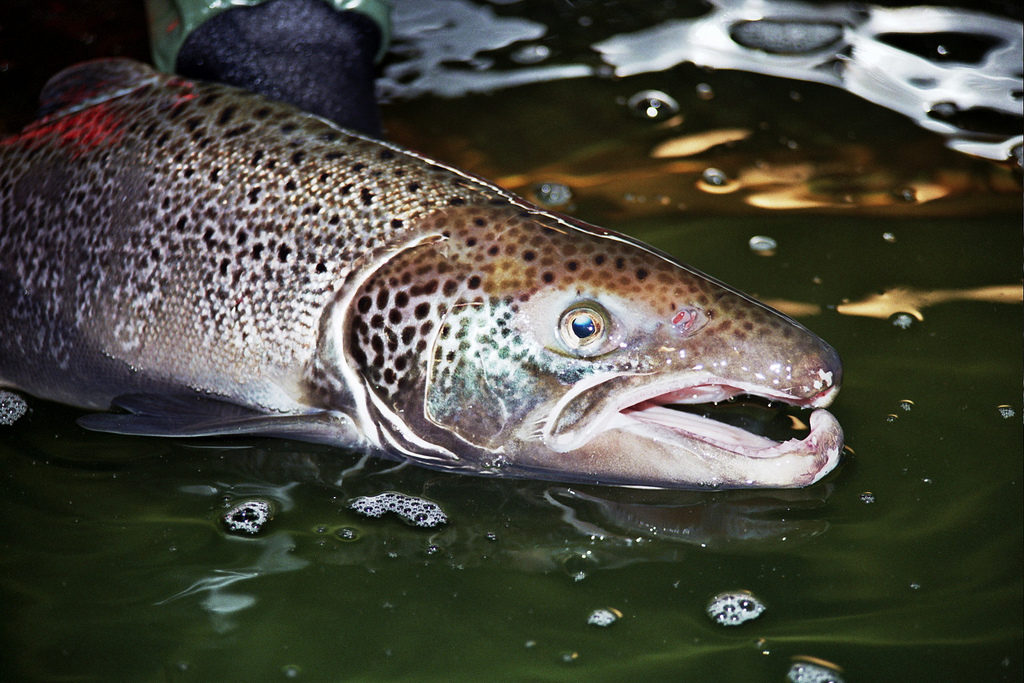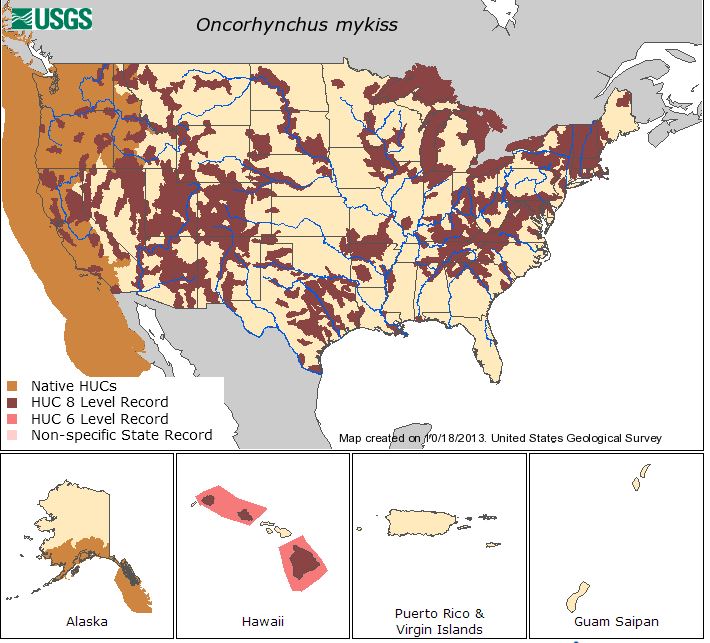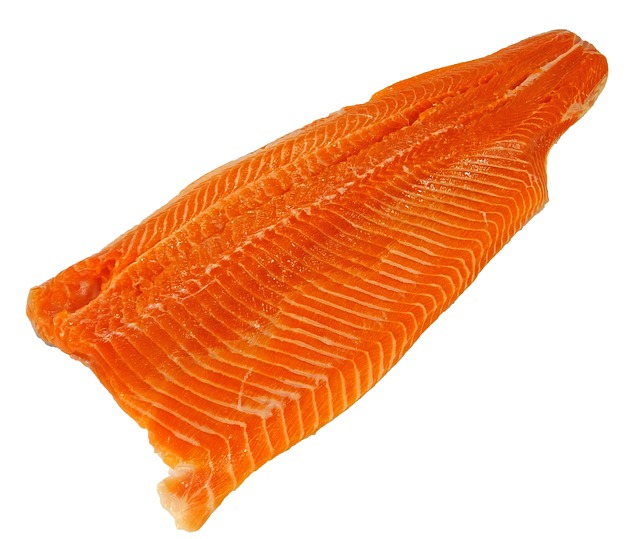While steelhead and rainbow trout may seem different, they are actually the same species, Oncorhynchus mykiss. Genetically, they are more or less identical. But despite their genetics, the two lead very separate lives.
Table of Contents
One Species, Two Life Cycles

Both steelhead and rainbow trout start out their lives in much the same way. They hatch out of eggs laid in freshwater streams, rivers, and lakes. “Normal” rainbow trout are perfectly content to stay there, spending their entire lives in the water body they were born in. They start spawning after two years, and most will weigh somewhere in the range of 1-10 pounds.
For some trout, though, a switch flips after 1-3 years in their freshwater habitat. Scientists are still trying to figure out what causes this change, but think it may be due to a mix of genetic and environmental factors. Whatever the reason, these trout start migrating to the sea, and will spend up to five years in saltwater. These are the steelhead. They can grow to be 20 pounds or more. When the time comes, they migrate back to the freshwater areas that they were born in to spawn.
Unlike salmon, steelhead don’t die after spawning, and some end up returning to the ocean. Others stay and spend the rest of their lives in fresh water. In fact, some steelhead never make it out to the ocean in the first place. If a barrier, natural or otherwise, blocks their way, a trout that might have migrated to salt water will stay in fresh water.
Earning Their Salt
Even out in salt water, not all steelhead are created equal. Fishermen have developed a lingo for steelhead that corresponds to the numbers of years spent in salt water.
- One-Salt or “Half Pounders” are steelhead that have spent up to a year in the ocean. While they’re known as “half-pounders,” they commonly range from 2-6 pounds in weight. Since they don’t spend long in salt water, they rarely venture out into the open ocean. Instead, they stay along the coast, often in tidal estuaries Some are not even sexually mature when they return to fresh water, and live out their lives much like the rainbow trout that never leave.
- Two-Salt fish spend two years in the ocean, and will go deeper and farther away from shore. When they return, they’ll weigh around 10 pounds, significantly larger than their freshwater cousins.
- Three-, Four-, and Five-Salt steelhead spend the longest amount of time in the ocean, and grow to remarkable sizes. The largest weigh can weigh more than 20 pounds, and 30 or more is not unheard of. The vast majority of steelhead will not spend more than four or five years in salt water before returning home.
How to Distinguish Between Steelhead and Rainbow Trout
The difference between steelhead and rainbow trout is an unsatisfyingly fuzzy line. It’s especially so when some areas have different regulations pertaining to steelhead vs rainbow trout. There are, however, telltale signs that can help an angler identify the trout they’ve caught.

- The biggest sign is, well, how big they are. On average, a steelhead is much bigger than a freshwater rainbow. If you catch a trout over about 26″ in length, there’s a very good chance that it’s a steelhead.
- A related characteristic is wear and tear. While freshwater rainbow trout can and do grow to the same size as their steelhead brethren, it takes them much longer to do so. The older the fish gets, the more likely it is to develop the scars of a tough life.
- Steelhead often have heavier spotting and brighter colors than freshwater rainbows. They are particularly known for their silvery sheen.
- Since steelhead return to fresh water to spawn, look for the signs of a breeding fish in the trout you catch. For males, the easiest way to tell is by looking at the mouth. Spawning males develop a pronounced hook in their lower jaw, known as a “kype.” Colors on both sexes will also be brighter during spawning. Spawning females are harder to identify, but generally have larger, softer bellies (filled with eggs). They also may have a small protruding bit near their anus called an “ovipositor.”
None of these characteristics alone is an indication of the fish being a steelhead, but taken in combination they can help identify one or the other. For example, a larger fish with bright colors and a kype that looks relatively unscarred is most likely a steelhead.
Lake-Going “Steelhead” Trout

This is a very contentious topic among some anglers, so be warned. If you want to get a group of West Coast and Great Lakes fishermen fighting, ask them about the definition of “steelhead trout.” Rainbow trout were introduced to the Great Lakes in the late 19th century and thrived in their new environment. They have established a population that mimics migratory habits of steelhead trout without ever going into the ocean. Instead, the Great Lakes are their massive waterbody of choice.
Anglers in the Great Lakes routinely call these trout “steelhead.” Whether this is correct or not depends entirely on what you believe is the defining characteristic of a steelhead vs a regular rainbow trout. If you believe that “steelhead” are defined by living in saltwater and migrating to fresh water when breeding, then Great Lakes “steelhead” are just big rainbows. If, on the other hand, you believe that the migration is the key part, regardless of the type of water, then Great Lakes can be called “steelhead.”
It’s worth noting again that “steelhead” are not native to the Great Lakes region. They are an introduced species, and their naturally-reproducing numbers are supplemented by a strong stocking program. When it comes to official recognition of steelhead for ecological and conservation purposes, they do not count. In fact, the argument is sometimes made that they are invasive and should not be promoted over trout native to the area.
Steelhead vs Rainbow Trout Taste
A lot of you reading this are not into fishing at all, you’re just hungry. You’ve gone to the supermarket before and noticed that “rainbow trout” is usually sold either in smaller fillets or as whole gutted fish, while “steelhead trout” is usually cut into thicker fillets or steaks. What’s the difference, you might ask?

Well, like everything about steelhead and rainbows, it’s complicated. Most trout that you’ll find at the supermarket is farmed. That means that the distinction between their migratory habits is moot. The main difference seems to be size. Farmed “steelhead” are grown in much the same way as salmon. They’re bigger, with deeper pink flesh, and are often raised to taste very much like salmon. To this end, many farmed steelhead are, like salmon, grown in salt water. However, there is no regulation in the US regarding the “steelhead” name, so there is no one way that steelhead is grown.
You can adapt most salmon recipes for steelhead trout, since the taste is very similar. If anything, steelhead will have a milder, less “fishy” taste than salmon. It’s becoming increasingly popular as a more affordable and sustainable option than farmed salmon, so you may start seeing it more in your local supermarket.
The “rainbow trout” trout label is usually used for smaller fish raised in fresh water. That means thinner fillets or whole fish, and the flesh is often a paler pink. The flesh is less “fishy” overall, but may have a gamier “muddy” quality to it much like some catfish. If you’re worried about this muddy taste, lemon juice can help counteract the compounds that cause it.
Conclusion
Steelhead and rainbow trout are two different varieties of the same fish. They often coexist in the same waterways, and it can be difficult to tell the two apart. However, their lives and physiology can be very different. There’s something to be said for the old line from US Supreme Court Justice, “I know it when I see it.” Catch enough of both, and you’ll start to get your own eye for the difference!

